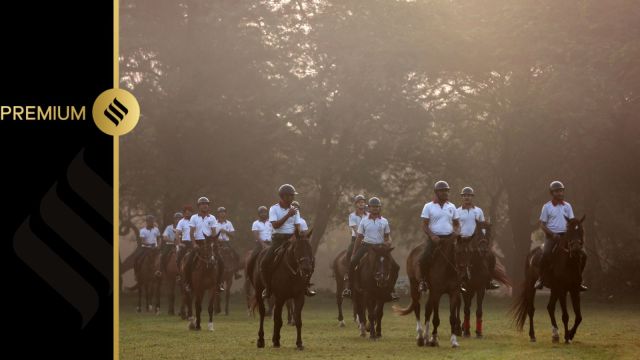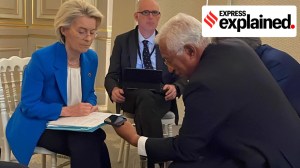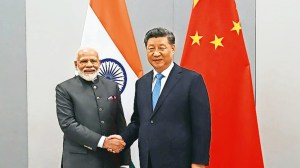At 4.30 am, a sliver of the 330-acre presidential estate starts coming to life. By 6 am — day after day, week after week, month after month, year after year, come rain or shine — 200-odd men in white polo necks and riding boots thunder out of the stables with their steeds.
On the grassy, muddy trails of their dedicated training ground in the nearby Ridge Forest area, the towering men and 100 tall horses ride, gallop, jump over obstacles like rails and cross water bodies to perfect their riding and sporting skills for an hour each day.

Their ceremonial escort duties as the President’s Bodyguard (PBG) means they operate with zero margin for error. Considered the personal troops of the President, the PBG take precedence in protocol over all other regiments and corps of the Army. The elite PBG has served all 15 Presidents so far since Independence.
Story continues below this ad
An illustrious past
On the sidelines of the vigorous morning training, PBG Commandant Colonel Amit Berwal tells The Indian Express that this most senior regiment of the Army traces its history to over 250 years — Benaras of September 30, 1773, to be exact. The regiment was first raised in Benaras when Raja Chet Singh sent 50 horses and 50 troops to then Governor Warren Hastings.
Having started out as the personal bodyguard of the Governor, the regiment was christened as Governor-General’s Bodyguard in 1774. In 1857, with the advent of the Viceroy, its name was changed to the Viceroy’s Bodyguard, says Colonel Berwal.
After Independence, the regiment reverted to the name of Governor-General’s Bodyguard. “Half the troops, horses and equipment went to Pakistan following Partition. In 1950, after India became a Republic, the regiment was given its current name,” he says.
 The PBG has close to 100 horses with bay, dark bay and grey coats. (Express photo by Gajendra Yadav)
The PBG has close to 100 horses with bay, dark bay and grey coats. (Express photo by Gajendra Yadav)
Seen leading the ceremonial escort during the Republic Day parade this year and riding to the right side of the President’s buggy, the PBG troops are trained to be the “best” cavalrymen, Colonel Berwal says.
Story continues below this ad
By origin, the PBG are a cavalry troop — that is, they are trained to fight on horseback. In 1942, during the Second World War, the regiment was equipped with armoured fighting vehicles and in 1944, they were trained as paratroopers, he says. “These military skills are still retained in the PBG. There is no other unit in the world in this format,” he says.
Though the regiment is now exclusively employed for ceremonial escort duties at the Rashtrapati Bhavan, PBG has served during war time and in military operations, including the 1962 India-China war and the 1965 Indo-Pak War. Since 1994, a detachment of the PBG has been deployed at Siachen, the highest and coldest battlefield, as part of Operation Meghdoot.
Besides a fitness centre, sporting arena, houses, office spaces and stables, the PBG campus, spread across a few kilometres, also has a temple and a gurdwara.
Life on the President’s Estate
Permanently stationed at the Rashtrapati Bhavan — they live with their families on the President’s Estate — the PBG rises at 4 am, says Junior Commissioned Officer (JCO) Naib Risaldar Kumbha Ram, who has been at the centre of many high-profile ceremonies.
Story continues below this ad
Stating that he is at the stables at 5 am daily and out by 5.45 am, Naib Risaldar Ram says, “After training the horse for about an hour, we groom, massage and feed them. That takes up a lot of our time. Even the saddles and ceremonial equipment has to be maintained.”
The most important part of the PBG’s day, he says, is to keep themselves fit so they can ride horses — “a strenuous exercise since the animals are at least five feet tall” — and to continue to be combat paratroopers. Naib Risaldar Ram says all PBG troops are required to clear periodic fitness tests. “You will not find a single PBG with a paunch,” he says with a laugh.
 Seen leading the ceremonial escort during the Republic Day parade this year and riding to the right side of the President’s buggy, the PBG troops are trained to be the “best” cavalrymen, Colonel Berwal says. (Express photo by Gajendra Yadav)
Seen leading the ceremonial escort during the Republic Day parade this year and riding to the right side of the President’s buggy, the PBG troops are trained to be the “best” cavalrymen, Colonel Berwal says. (Express photo by Gajendra Yadav)
While many PBG troops are the third or fourth generation in their families to serve the President, joining these elite ranks is easier said than done — an aspirant should be at least 6 feet tall to make the cut since “they ride equally tall horses”.
In fact, the PBG rides the tallest horses in the Army — ones that are at least 5 feet tall. Bred by the Army’s Remount and Veterinary Corps, these tall geldings are allotted to the PBG, say officials, adding that uniformity in appearance is a must for both the troops and horses.
Story continues below this ad
The PBG has close to 100 horses with bay, dark bay and grey coats. Traditionally, being the most senior regiment, the mane and tails of the PBG horses are not trimmed.
Recruitments to the PGB are held every year. Young jawans join as “Sowars”. There are six ranks in the unit, the most senior being that of “Risaldar Major”. While it takes about two-three years for a young bodyguard to become proficient enough for a basic dismounted ceremonial parade, it can take five-six years to be employed in a mounted escort parade, astride one of the 100-odd horses.
1/8

On the grassy, muddy trails of their dedicated training ground in the nearby Ridge Forest area, the towering men and 100 tall horses ride, gallop, jump over obstacles like rails and cross water bodies to perfect their riding and sporting skills for an hour each day. (Express photo by Gajendra Yadav)
2/8

Endless hours of training enable these troops to undertake ceremonial escort duties, which include standing still in their ornate uniforms — safas (turbans) with a straight turla on top and shoulder flashes saying President’s Bodyguard — while holding 9.9-foot-long lances. (Express photo by Gajendra Yadav)
3/8

By origin, the PBG are a cavalry troop — that is, they are trained to fight on horseback. (Express photo by Gajendra Yadav)
4/8

The PBG rides the tallest horses in the Army — ones that are at least 5 feet tall. (Express photo by Gajendra Yadav)
5/8

The PBG has close to 100 horses with bay, dark bay and grey coats. (Express photo by Gajendra Yadav)
6/8

Horses and troops cannot be changed frequently because ceremonial training and temperament are built with repetitive training. (Express photo by Gajendra Yadav)
7/8

Though the regiment is now exclusively employed for ceremonial escort duties at the Rashtrapati Bhavan, PBG has served during war time and in military operations, including the 1962 India-China war and the 1965 Indo-Pak War. (Express photo by Gajendra Yadav)
8/8

It takes a horse a few years of training to become proficient for high-prestige events like the Republic Day parade. (Express photo by Gajendra Yadav)
However, to feature in the same frame as the President takes close to a decade of “tapasya (gruelling training)”.
Endless hours of training enable these troops to undertake ceremonial escort duties, which include standing still in their ornate uniforms — safas (turbans) with a straight turla on top and shoulder flashes saying President’s Bodyguard — while holding 9.9-foot-long lances. “The time spent in the saddle never gets wasted,” says Risaldar Major Vijay Singh.
Story continues below this ad
Horses have a relatively faster career trajectory — a horse that comes to the PBG at the age of about five years can be presented in a ceremonial escort of the President after at least two-three years of training. Once inducted, the horses remain with the PBG for 15-16 years, says Colonel Berwal.
“Horses and troops cannot be changed frequently because ceremonial training and temperament are built with repetitive training. It takes a horse a few years of training to become proficient for high-prestige events like the Republic Day parade,” he says, adding that their horses — the other half of the PBG — have never disappointed during formal ceremonies.
The service duration of PGB troopers is in accordance with Army norms. For a Risaldar Major, that term is about 32 years of service. When he retires, he does so on horseback.
“Last year, five JCOs who retired on January 31 accompanied the President for the joint address to both Houses of Parliament. By the time the regiment escorted the President back, it was about 1.30 pm — and it was time for the JCOs to retire,” recalls Colonel Berwal.
Story continues below this ad
Rehearsing for the parade
Annually, the PBG undertakes an average of 140 ceremonial events at the Rashtrapati Bhavan, including the weekly change of ceremonial guard, beating the retreat ceremony, administering the oath of office by the President, and presentation of credentials by ambassadors and high commissioners, among others. Nearly 70 of these annual events require the participation of horse-mounted troops.
Officials say a national-level mounted parade like the one seen on Republic Day takes about two months of practice to master “even though it is done year after year”. The eve of the parade too involves a lot of prep work.
Given the high-profile Republic Day parade, practice sessions start when the weather in Delhi is at its harshest — December and January. “In the bitter Delhi winter, our horses and troops escort the President on Republic Day and when the Tricolour is unfurled on the command of ‘Rashtriya salute, madhya dekh’ on Kartavya Path,” says Colonel Berwal.
To acclimatise the horses to ambient noises on Kartavya Path that day, speakers in stables on the President’s Estate blare martial music and ambient noises at the same volumes that are likely to be heard on Republic Day.
Story continues below this ad
“For over two odd months, the horses are gradually exposed to sounds we think they can expect. This keeps the horse’s from feeling anxious on the day of the parade — something that is very important for the safety of both the horse and the rider,” says Naib Risaldar Ranapratap Singh, equestrian training JCO and a national-level athlete in equestrian sports.
An official says even the PBG does not know how the area will be prepared for the parade each year. “Maybe more loudspeakers will be added or more screens or more security vehicles or personnel. We usually don’t know till the last day or so. So we prepare the horses for all eventualities so that they stay still while maintaining the formation during the ceremonial escort,” he adds.
“There is no scope for error when it comes to ceremonies. Even our horses have to be the best. And they have never disappointed,” says Risaldar Major Vijay Singh.


 The PBG has close to 100 horses with bay, dark bay and grey coats. (Express photo by Gajendra Yadav)
The PBG has close to 100 horses with bay, dark bay and grey coats. (Express photo by Gajendra Yadav) Seen leading the ceremonial escort during the Republic Day parade this year and riding to the right side of the President’s buggy, the PBG troops are trained to be the “best” cavalrymen, Colonel Berwal says. (Express photo by Gajendra Yadav)
Seen leading the ceremonial escort during the Republic Day parade this year and riding to the right side of the President’s buggy, the PBG troops are trained to be the “best” cavalrymen, Colonel Berwal says. (Express photo by Gajendra Yadav)





































